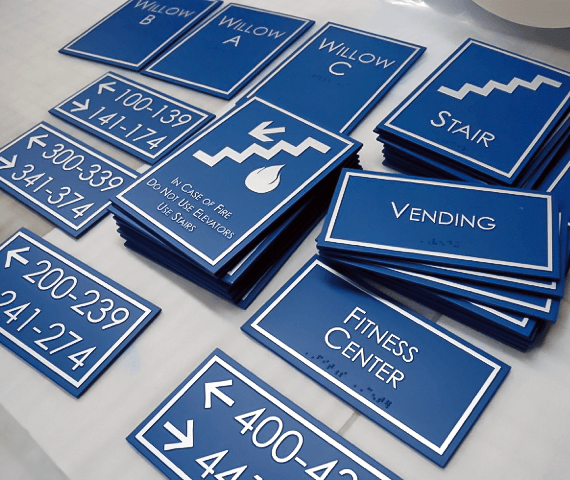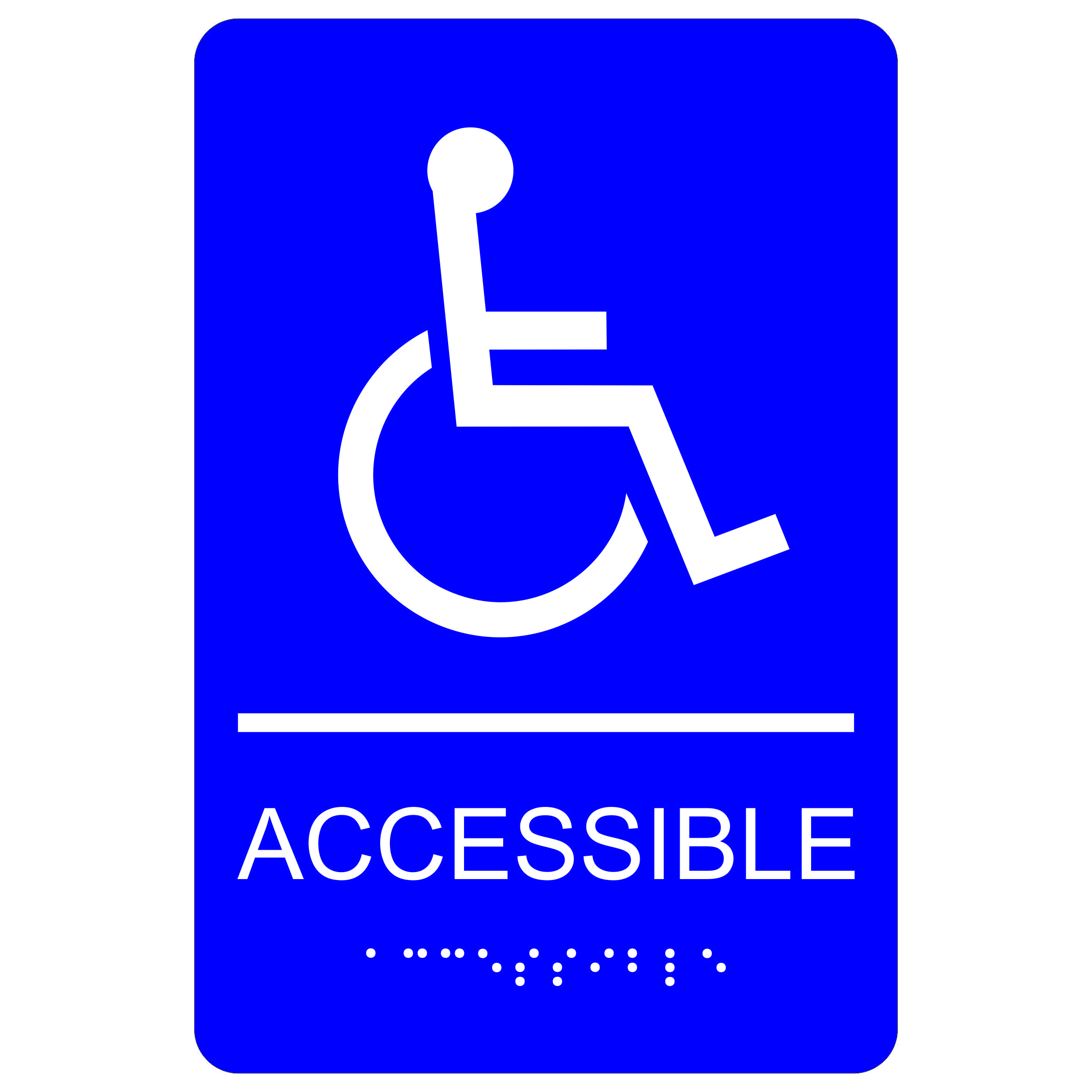Just How ADA Signs Boost Access for Everyone
Just How ADA Signs Boost Access for Everyone
Blog Article
ADA Signs: Ensuring Availability and Compliance in Public Spaces
ADA signage plays a vital function in assuring accessibility and conformity within public rooms, substantially adding to an inclusive atmosphere for people with disabilities. By adhering to ADA standards, signage not just promotes navigation however additionally underscores an organization's commitment to variety and equal rights. As we discover the subtleties of ADA signage, from tactile features to design ins and outs, it's essential to think about just how these elements coalesce to promote the legal rights of all customers. What are the typical challenges organizations deal with in preserving compliance, and how can future patterns in signs continue to drive access onward?
Importance of ADA Signage
In contemporary society, the importance of ADA signage extends past simple compliance with legal mandates to personify a dedication to inclusivity and access for all people. These indications are crucial in developing settings where people with specials needs can browse public spaces with the same convenience and self-reliance as those without specials needs. By supplying clear and standardized details, ADA signs guarantees that every person can access centers, services, and details without obstacles.
The significance of ADA signage hinges on its capacity to improve the high quality of life for individuals with disabilities by advertising equal access. It eliminates the challenges that might or else impede their ability to get involved fully in area life. Moreover, these signs offer as visible indications of an organization's dedication to variety and equality, mirroring wider societal values that promote the civil liberties and self-respect of all individuals.
Furthermore, ADA signs plays a vital role in public security. By directing people to leaves, bathrooms, and various other vital centers, it guarantees that all individuals, no matter physical capability, can leave securely during emergencies. In summary, ADA signs is not just a regulative need but a powerful tool for cultivating a inclusive and fair society.
Crucial Element of Conformity

Placement is important; indications should be set up in locations that are quickly visible and reachable. Usually, signs ought to be installed between 48 and 60 inches from the ground to ensure ease of access for both standing and wheelchair users. Tactile components, such as Braille, are essential for people with aesthetic disabilities, offering crucial information in a non-visual format.
High-contrast shades in between the text and background are essential to boost readability for individuals with low vision. The ADA mandates particular comparison proportions to guarantee clarity. In addition, personality dimension is a key consideration, with minimum elevation requirements dictated by the checking out distance to ensure readability from numerous angles.
Style Considerations for Accessibility
Creating easily accessible signage calls for a thorough method to guarantee it satisfies the needs of all customers, especially those with disabilities. This involves considering numerous style components that boost readability and use. Trick aspects include the choice of typeface, color comparison, and responsive functions. Fonts must be sans-serif, with straightforward and clear letterforms, to help with simple analysis. The size of the text is just as vital, with ADA guidelines recommending a minimal height based on viewing range to ensure readability.
Contrasting shades in between text and background are vital for exposure, especially for people with aesthetic disabilities. Furthermore, tactile elements, click to investigate such as Braille and raised personalities, are essential for individuals who are blind or have low vision.
Furthermore, the positioning of signs plays a substantial function in availability. Indicators should be set up in locations that are unhampered and conveniently reachable. Ensuring that signage is installed at ideal elevations and angles enables all individuals, including those using mobility devices, to communicate with them successfully.
Common Blunders to Stay Clear Of

One more widespread error is the inaccurate placement of signs. ADA guidelines specify precise height and area requirements to make certain that indications are easily visible and obtainable by all individuals, consisting of those using mobility devices. Overlooking these standards not only obstructs accessibility however additionally runs the risk of non-compliance with lawful standards.
Furthermore, not enough contrast in between message and background is a regular oversight. Ample contrast is necessary for readability, particularly for individuals with reduced vision. Developers sometimes select shades that are visually attractive however do not have the necessary contrast, making the message difficult to determine.
Finally, some designers fail to include responsive elements, such as Braille, which are vital for individuals that are blind. Leaving out these attributes he has a good point not only results in non-compliance with ADA policies however likewise restricts accessibility for a sector of the population that relies upon tactile info.
Future Trends in Signage
Improvements in innovation and enhancing understanding of inclusivity are forming the future fads in signs layout. As culture ends up being much more mindful of varied demands, the assimilation of smart innovations into signage is getting traction. Digital signs, for circumstances, is evolving to include real-time updates and interactive functions, which can be critical in providing vibrant details in public rooms. These indicators often incorporate touch screens or gesture-based controls, enabling users to navigate content tailored to their specific needs.
One more emerging pattern is the application of enhanced reality (AR) to improve user experience. AR-enabled signs can overlay digital info onto the physical environment, supplying visually impaired individuals with auditory or haptic feedback. ADA Signs. This modern technology not only boosts availability but additionally develops an engaging experience for all customers
Sustainability is likewise a significant aspect affecting signage patterns. Environment-friendly materials and energy-efficient illumination solutions are being prioritized to straighten with global ecological objectives. Furthermore, improvements in materials science are causing the growth of more long lasting and weather-resistant indicators.
Conclusion
ADA signage plays a vital role in ensuring availability and conformity within public rooms by incorporating tactile elements, high-contrast colors, and calculated placement. The adherence to ADA standards not only facilitates safe navigation for people with disabilities but also represents an organization's dedication to diversity and inclusivity. By avoiding common mistakes and embracing future trends, public spaces can continue to advance these values, ensuring that the rights and dignity of all people are valued and promoted.
ADA signs plays an essential role in guaranteeing ease of access and compliance within public rooms, significantly adding to a comprehensive atmosphere for individuals with disabilities. As we discover the subtleties of ADA signage, from tactile attributes to make details, it's vital to think about exactly how these aspects integrate to promote the civil liberties of all individuals.In modern culture, the relevance of ADA signage expands past simple compliance with lawful mandates to embody a dedication to inclusivity and availability for all individuals. By giving clear and standard information, ADA signs guarantees that everyone can access centers, services, and details without barriers.
ADA signs plays an important role in ensuring accessibility and conformity within public spaces by including tactile components, high-contrast colors, and critical placement. (ADA Signs)
Report this page